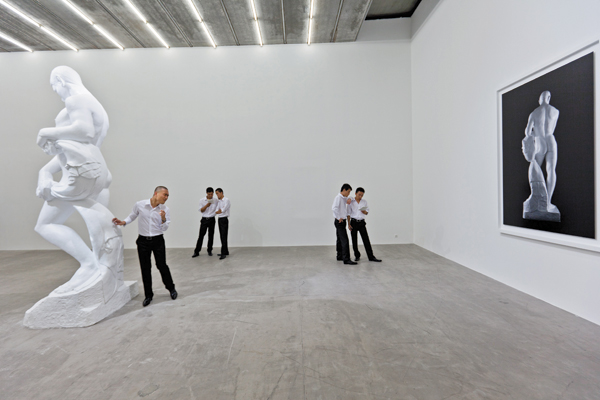 |
|
Galerie Urs Meile is a Swiss gallery with a branch in Beijing, exhibiting contemporary arts. Sun Yuanqing / China Daily |
Hundreds of Beijing's art outlets look to the local market and artists to see them through troubled times, Sun Yuanqing reports.
The winter has passed, but the chill still lingers in Beijing's art districts. With several local and foreign galleries shutting down in the past two years, shadows of doubt are falling on the capital's glittering status as an Asian art center.
In spite of boasting a large community of artists, most of the city's galleries are struggling for attention and support.
Of the 1,560 galleries in China, 742 are in Beijing. Fewer than 7 percent of the national total were able to make ends meet in 2012, said Cheng Xindong, director of the Art Gallery Association and founder of Xin Dong Cheng Gallery.
But like the pictures in their galleries, many are hanging on, hoping to ride out the rough patch and staying loyal and close to their artists.
"The business environment is tough but it's worth it because the artists are here," said Meg Maggio, founder and director of the Pekin Fine Arts gallery. "If anything is driving the bus, it's the artists."
Pace Beijing, the China branch of the New York gallery, said it is still hopeful about Beijing as it tries to fulfill its original intention of "connecting to the local artists".
"They are still the most creative breed in Chinese contemporary art circles. As long as they are here, there will be art," said Li Jia, director of Pace Beijing.
Pifo New Art Gallery, an art space specializing in new and emerging Chinese artists, has a branch in Hong Kong, but says its focus will remain in Beijing.
Threatened by aggressive auction houses and having a loose system of artist representation, Beijing galleries have been battling to survive since they first began to appear on the scene in the early 2000s.
In contrast to the Western art market, where galleries play a dominant role, those in China are reportedly selling less than half as much artwork as the auction houses.
Also, the contracts between artists and the galleries in China are often ineffective.
"The artists in China are very flexible. A long-term, steady relationship and collaboration can be very hard," said Ma Xuedong, executive director of the Art Market Research Center.
While the AGA succeeded last year in getting the authorities to reduce the customs duty on imported art works to 6 percent from 12 percent, value added tax still stands at 17 percent.
A crackdown on tax evasion by art buyers early last year also contributed to the gloom because no clear regulation has been issued yet. This has added to the uncertainty of the market.
"Working in China has become more difficult in recent years due to high import taxes and bureaucracy over the import and export of contemporary art," said Urs Meile, founder and director of Galerie Urs Meile, a Swiss gallery with a branch in Beijing. "If Beijing is to have a chance to play a leading role among the competing art centers in Asia in the future, it is vitally important that those problems are solved and that the structures are improved."
|
|
|
|
|
|
|
|
|
|
|